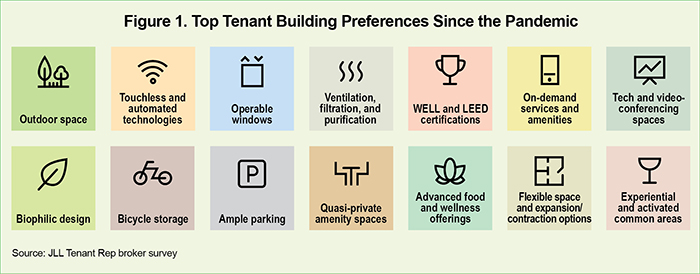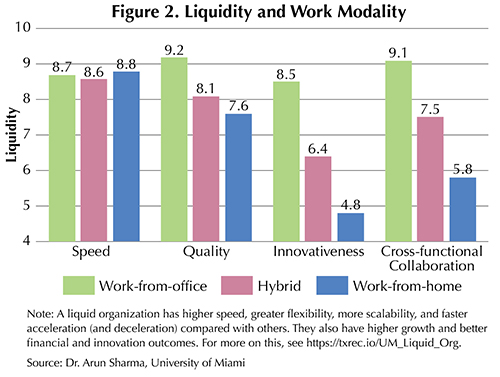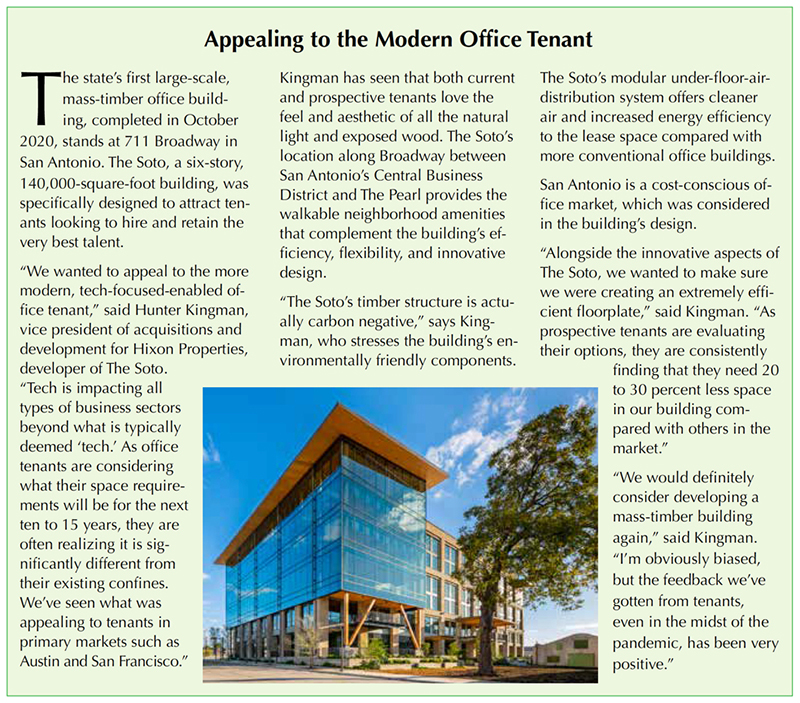The past 18 months show a flight to quality in office space leases. A corresponding trend suggests higher retention of high-value talent in companies with a strong culture. Understanding and acting on this correlation could transform the Great Resignation into the Great Return for office building owners willing to invest.
quick links
One fallout from the pandemic is the mass exodus of many Americans from the workforce, a phenomenon Texas A&M University professor Anthony Klotz first called the “Great Resignation.”
What does the Great Resignation mean for office space demand in the coming years? The answer will be the difference between success and failure in an important sector of commercial real estate. A clear-cut solution is needed that can mitigate the impact, for better or for worse.
To address this question and others, Texas Real Estate Research Center Research Economist Dr. Harold Hunt interviewed Steve Ramseur, JLL chief innovation officer, Americas, and executive professor for Texas A&M’s Master of Real Estate program; and Bucky Banks, associate director and executive assistant professor for Texas A&M’s Master of Real Estate program in Mays Business School.
Hunt: There’s been increasing concern about employee attrition during the pandemic and its impact on future office space requirements. How are forward-thinking companies addressing this problem as it relates to investment in their physical space?
Ramseur: I think one antidote to the Great Resignation we’ve been witnessing may be hiding in company office space. The U.S. office market is experiencing a post-pandemic flight to quality, but it’s a specific type of quality. Our research at JLL shows net absorption of about 40 million square feet in U.S. office buildings renovated since 2015. Meanwhile, we’ve recorded negative net absorption of about 189 million square feet for the rest of the market, the older properties.
Since 2015, about one in four Americans quit their job. One possible answer to converting employee attrition back to attraction is targeted capital investments in office space. We’re seeing companies with Class A cultures invest in the renovation of their Class A space. As a result, they’re attracting and retaining the best workers.
At JLL, we’ve been seeing some extremely favorable office concession packages. Some landlords are offering up to nine months free rent and more than $70 per square foot in tenant improvements. Top-tier companies are continuing to lease large blocks of Class A space all across the country, but they’re also spending their tenant improvement money in innovative ways.
Google is one example. The company recently took down 679,153 square feet in Atlanta and now has an A+ employee retention score. More than 80 percent of their employees say they’re excited to go to work every day. This places them in the top 5 percent of all companies for retention, work culture, and happiness according to comparably.com, a firm that compares employers, brands, and salaries.
Other companies, like Amazon and Goldman Sachs, scored high in these areas as well. So, the best companies are willing to invest in their culture. And part of that investment is putting capital into the right tenant improvements in modern, high quality properties (see sidebar).
Hunt: What’s your take on why so many people have been quitting their jobs?
Banks: Around 30 million people wound up quitting their job in 2021. That’s despite persistent economic uncertainty and the COVID-19 pandemic. We see this trend across nearly all demographic categories. Surprisingly, the bulk of quits are among workers age 30 to 45, and that age group has registered a year-over-year increase of more than 20 percent. Such high attrition in this age cohort isn’t typical.
Popular opinion attributes job quits to a number of factors, including burnout, better-paying opportunities elsewhere, and the desire for greater work flexibility. But a deeper dive into the problem reveals a different root cause. A 2021 report by McKinsey & Company discovered that a lack of purpose and meaning at work, combined with an absence of a sense of belonging, were much stronger motivations for quitting. I believe these factors represent the real core disconnect between what employees and their company value.
A November 2021 article in the Harvard Business Review discovered something similar. Research was carried out over 20 years and captured more than 800,000 data points. Workers were asked what they really value at work. Both white-collar and blue-collar workers across all industries identified four major areas. They were purpose, value, belonging, and certainty. The survey also showed these four worker priorities have remained consistent across changing political, social, and economic environments as well as generational cultures.
What’s interesting is how consistent these answers are over time. What workers value really hasn’t changed that much, but the global pandemic has finally brought these established values to the surface.
So, the pandemic’s impact on work has caused a shift in worker behavior. Worker resignations have been the clearest sign of this shift. When firms don’t address these core issues, workers respond with their feet and exit the company.
Hunt: How do these worker values influence the built space, the actual bricks and mortar?
Ramseur: If companies intend to retain and attract high-impact talent, they first need to lay out their corporate values explicitly. Those values will translate directly into the built environment. At JLL, we’ve found that about two-thirds of the global workforce wants to alternate between two different work modes: working from home or the office. The problem is only 8 percent of international organizations have more than 5 percent of their space that could be reconfigured to meet those needs. This gap creates real opportunities for office investors, owners, and brokers.
We think the consequences of this significant change in worker behavior — and leadership’s response to it — are going to have a long-term impact on office space. Corporate leadership has to acknowledge this transformation in worker behavior is natural and potentially permanent.
Companies can begin to adjust to this new environment by aligning their culture with the capital they invest in their space. Their most valuable assets, their people, often spend more than half of their waking hours in the office.
Investments in new building amenities, like touchless and automated technologies will be important. Biophilic design, a concept that uses architectural design and construction methods to connect people to nature and outdoor space, also appeals to the best talent. But leadership must be willing to invest their capital in state-of-the-art health and wellness features (Figure 1).

Hunt: How important is the link between a firm’s corporate culture and investment capital?
Banks: We know that when commercial real estate professionals connect their real estate business and workplace strategy directly to a potential tenant’s corporate culture, employee retention rises. Research by the Institute for Innovation in Large Organizations found companies such as Uber, Lyft, Amazon, and Google have been successful at merging their workers’ styles, skills, and individual work preferences with their physical space. So, companies with a record of intentionally emphasizing a corporate culture of values and purpose have consistently retained more workers through the pandemic.
Hunt: Is worker loyalty an important factor in worker retention? If so, how can companies create a culture that promotes more worker loyalty?
Banks: Trustworthy leadership is key to worker loyalty. A senior strategy leader at Bloomberg had a great observation about worker trust. He argued we’ve been thinking too long about how much we can trust workers to make responsible decisions and get their work done if they aren’t in the office. The more important question is how well we earn their trust. Physical space is an ecosystem that can bind that trust between leadership and the workforce.
A 15-year study of more than 3,200 business leaders published in the Harvard Business Review found that trustworthiness was the most valuable characteristic inside leadership ranks. McKinsey & Company also discovered that leaders who were considered trustworthy did four things: they embodied their stated values, they dignified their workforce, they practiced transparency within the bounds of discretion, and they built bridges to foster unity among their workers.
Hunt: How important is matching an employee’s preferred work style to their preferred work mode?
Ramseur: We need to allow employees to match their personal skill sets with the work they do. But matching their individual work tasks with their personal needs should be done through self-management. I think part of a solution to the Great Resignation and its impact on office space is promoting self-management of individual workers.
The built environment will have to respond and adapt to this change in work style. We’re really on the front edge of a new paradigm. The built environment best suited to accommodate self-management requires a different type of space. Areas will be needed for focused individual workflows. Collaborative rooms can be used for productive workflow. Finally, public forum space will be needed for the open discussion and distribution of ideas.
Banks: The ability to reflect on these changes in the built environment will be critical to retain workers in the future. I also think features like more natural spaces will be needed to produce greater well-being and fulfillment among workers. This human-centric environment that can accommodate different work modes isn’t something new. It’s been a foundation for labor practices since the first Industrial Revolution. But the trend is finally growing. Early adapters of the movement to self-management are seeing it as more of a marketplace for workers rather than the traditional command-and-control workplace.
Just remember that the need for office space isn’t going to disappear. In fact, a recent study out of the University of Miami found that quality, innovation, and collaboration outcomes are currently better when executives work from the office than when they work from home (Figure 2). We recommend corporations invest tenant improvement dollars in dynamic, technology-rich built environments that facilitate team dynamics that enable the trust to enrich the organization’s remote and virtual team components.

Hunt: What’s the bottom line for creating a winning office environment?
Ramseur: Worker loyalty and trust are the cornerstones of building a sense of purpose for a workforce. A corporate culture that develops worker loyalty will create a greater understanding of belonging and purpose among employees. The connective tissue for a healthy culture is trust, which encourages self-management.
Early research suggests companies with these dynamics are investing capital dollars in above-market tenant improvements in their work environment. Owners, managers, brokers, and other real estate professionals would do well to ride the wave of the future of work by investing accordingly.

____________________
Dr. Hunt ([email protected]) is a research economist with the Texas Real Estate Research Center at Texas A&M University.
Takeaway
Spring 2022
You might also like

Development
6 minute read
Feb 20 2023
A Towering Task
Logistical Challenges of Office-to-Residential Conversions
Reduce, reuse, and recycle are the “three Rs” of protecting the environment. Nowadays, some commercial property owners are finding new uses for old office buildings, adding a fourth R: residential.

PUBLISHED SINCE 1977
Tierra Grande
Check out the latest issue of our flagship publication.
SUBSCRIBE TO OUR
Publications
Receive our economic and housing reports and newsletters for free.











